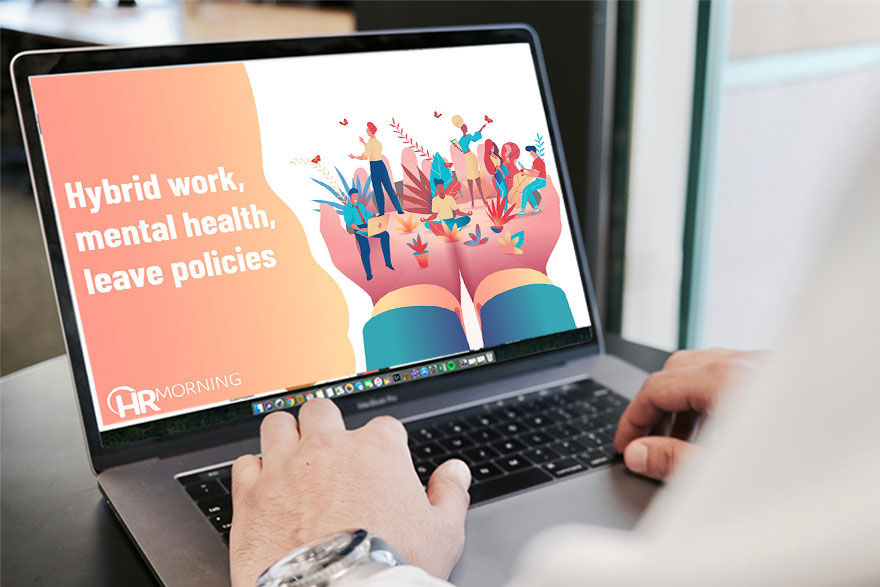While most people were happy to say goodbye to 2021 and welcome in 2022, there’s still some apprehension. How can there not be after the past two years? But now that we’re over a month into 2022, how’s everything going? Is the business running smoothly? Are there things that need to be adjusted?
If you’re feeling that something isn’t just right, maybe look at the top three benefits trends of 2022 and see if everything’s copasetic.
No. 1: Flexible, hybrid work arrangements
Yeah, yeah, yeah, you’ve heard it before. But chances are you’re going to hear it again and again.
Why?
It’s considered the No. 1 benefit employers can provide outside of salary and standard benefits.
“Hybrid work is here to stay,” said Jennifer Schoenig, VP, Guardian, in the webinar, The Future of Benefits. “We’ve become accustomed to new behaviors and lifestyles. Work and life have intermingled more than they did before. Now it’s the norm for most of us.”
Schoenig, who works from home, was able to coach softball for the first time. Working in the office with the time demands and commuting never allowed it previously.
But not everyone wants to be at home 100% of the time. Some people miss being with their colleagues. Others, who live alone or have children, want to get out of the house for a while. And each side has its benefits.
In-office perks
Being in the office allows employees to grow their networks faster and build those interpersonal skills. And you don’t have to be as intentional about scheduling meetings to have a conversation you could probably just do in the hallway or at a colleague’s desk.
For employers to attract and keep talent, it’s important in 2022 to be able to say you have a flexible work arrangement, whether it’s how many days you come in or what time you come in.

“And nearly two-thirds of employers are planning to have at least a portion of their workforce be remote in 2022,” said Gene Lanzoni, SVP, Thought Leadership, Guardian. “One reason for that is they’re better prepared for remote work than ever before. A majority have implemented technology to support remote work since the pandemic started. Compared to a year ago when most employers were concerned about retaining customers and growing their business again. Now, in 2022, it’s about retaining employees and figuring out the optimal workplace model.”
Community, engagement
But there must be an emphasis on fostering community and keeping remote workers engaged.
So don’t forget about those people who are working from home, advises Schoenig. “Invite them into the office. Let them know they’re welcome at any time. And for those who aren’t local, invite them to be part of the conversation.”
In addition, she suggests using video meetings because then you know the person is paying attention and not multitasking. And ensure you’re treating people equitably in terms of assignments. “Don’t just give things to the people sitting right outside your door.
For those employees who aren’t jazzed about having to come into the office, how do you make it a place they want to be?
You have to make sure employees can’t say, “Why the heck did I come in here today. I could have done this at home!”
Schoenig said Guardian deals with this by having core days which are Tuesday, Wednesday and Thursday. On those days they hold things like Free Lunch Tuesday and Wellness Wednesday. They try and change it up and do programs that offer employees things they aren’t getting at home. People see it as they are getting something. Not just as an opportunity to collaborate.
“Really make it a great experience when someone comes in, so it’s well worth their time,” advises Schoenig.
No. 2: Improvement of emotional & mental health program
Why the constant focus on mental health?
Well, let’s face it. The last few years haven’t been easy. Add to that, one in five adults experience mental health issues every year, and 55% of adults with mental health disorders go untreated.
It’s been that way for years. It’s just that the pandemic put a bigger spotlight on the issues and got more people talking about it which has reduced the negative stigma.
And while many employers do offer mental health resources, the problem is they’re underutilized. So how do you improve employee utilization of mental or emotional health resources?
Accessibility
Accessibility to care is one of the biggest impediments. People just don’t know where to start.
“First off, mental health benefits need to be accessible,” said John Modica, Head of Go-go-Market Strategy, Guardian. “And the access needs to be digital, and you need a variety of resources that flex to the needs of employees. Care options should include self-pace cognitive behavioral therapy tools, as well as treatment aligned to the needs of each individual. This can include coaching, help navigating care, therapy – both digitally enabled and in person – and lastly options for medication management.”
Employees can’t use these benefits if they aren’t aware of them. Take the time to communicate benefits often and work with your care provider to ensure there’s visibility into employee utilization and the outcome is achieved.

Mental health programs also must be tailored to fit differing expectations of the multiple generations.
To keep and attract the cream of the crop, companies need to prove they care about their employees. And one way to do that is to show you care about their mental health and well-being.
Given the different needs and perceptions of the generations, a one-size-fits-all approach rarely works. “There are, however, certain things you can do to tailor employee benefits for each generation,” said Modica. “For example, Millennials value benefits choices, paid time off, the ability to work remotely, control over their schedule and a great deal of flexibility. Delivering to these needs may contribute to better mental health.”
Also, listen to your employees wants and needs when it comes to options for benefit packages.
No. 3: Implement a holistic employee leave strategy
The pandemic has caused 75% of employers to change their unpaid leave policies. And this trend will continue through 2022, according to a Guardian study.
This may not be surprising when you think about the fact COVID-19 prompted brand new or separate COVID-19-related policies. It was a must. And now 80% of employers said that senior leadership’s awareness of the “importance of leave management” has increased significantly due to COVID-19 and the number of employees that had to take leave to care for a family member or their own illness.
“COVID-19 definitely shifted the mindset of leave management and gave employers the opportunity to really hit a reset button on leave policies,” said Garlande Patz, Sr. Absence Management Practice Leader, Guardian. “So, we’re seeing the pandemic put that spotlight on the importance of supporting the emotional well-being of employees and realizing that many employers didn’t have policies or process in place that really permitted employees to take paid time off to care for a family member.”

From a policy perspective there’s been a huge growth in the number of companies that are offering paid family care benefits. In part it’s due to COVID-19, but it’s also due to the introduction of numerous paid state leave regs many of which do include coverage for family care. And employers want to ensure that their company policies are keeping up with those state benefits as well.
From a process standpoint COVID-19 has also highlighted some gaps, the biggest one being the lack of education that employees have regarding their company’s leave benefits. When it comes to leave, employees really want to know what benefits are available to them, where to go to read about their benefits, and then how to claim the benefits when they need them.
Paid leave, mental health priorities
So COVID-19 really forced employers to review the policies they offer to their employees to make sure they’re meeting employee needs, but then also making sure that the policies are clearly defined, easy to understand and accessible so that employees can use them.
And for 2022 the top two leaves that’ll take front stage are paid leave and mental health, noted Patz. The expansion of paid company leave will continue to be front of mind for employers in 2022. However, employers also need to be mindful of the rapidly evolving leave landscape.
“The complexity and compliance of leave is a concern, and when you talk about that you also have to look at state leave and accommodations under the ADA,” said Patz. “So, employers really need to be prepared to enforce the complexities there, as well as the added complexities from COVID-19 vaccine mandates and any legally required exemptions or related accommodations.”
Employee health, productivity
That’s a lot to deal with in and of itself, but there’s also a renewed focus on employees’ health and productivity. So, employers really need to ask themselves how they can keep employees healthy and productive. Burnout is still prevalent thanks to the pandemic which of course takes a toll on employees’ mental health.
“So regardless of employer size in 2022 I think a focus really does need to be on mental health in the workplace,” said Patz. “What resources are available to employees? How are employees made aware of these resources? How does the company culture support mental health to begin with?”
When it comes to challenges in 2022, smaller firms generally face more barriers when we’re talking about offering paid company leave when compared to larger firms. But these benefits are vital for any firm.
These are the types of perks that are going to attract and retain top talent moving forward. Ping pong tables at lunch are a thing of the past now. Employees are really looking at the benefits package.
And remember employees want to be able to access their leave information, file a leave request, get status updates, and they want this through multiple digital channels.
Source: hrmorning.com, by Renee Cocchi, Photo: Unsplash
